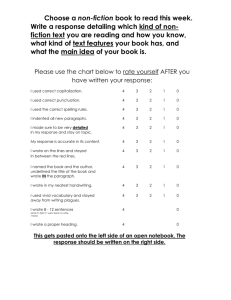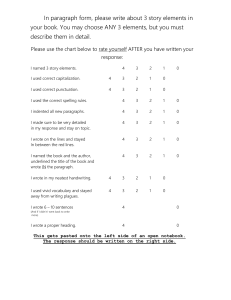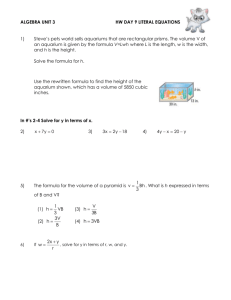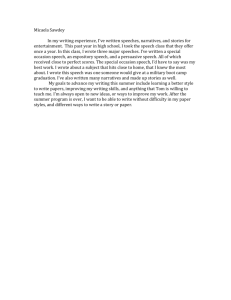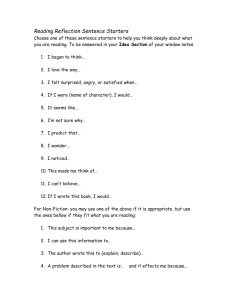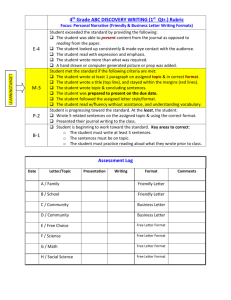FREE AT LAST? 5/10 - Deans Community High School
advertisement
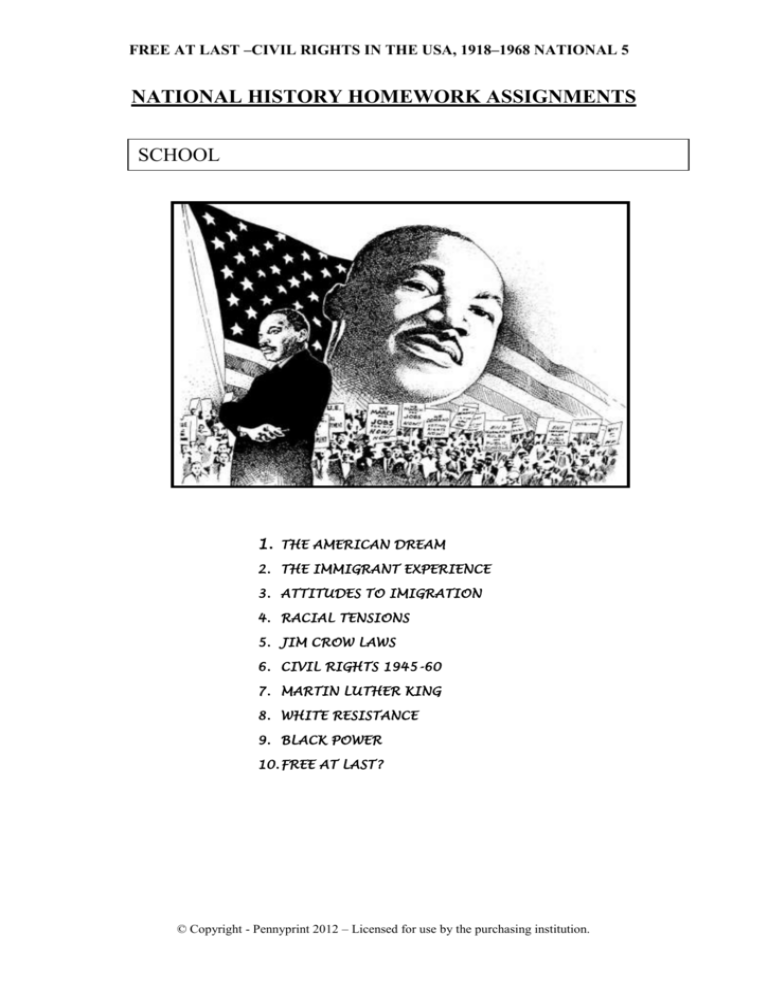
FREE AT LAST –CIVIL RIGHTS IN THE USA, 1918–1968 NATIONAL 5 NATIONAL HISTORY HOMEWORK ASSIGNMENTS SCHOOL 1. THE AMERICAN DREAM 2. THE IMMIGRANT EXPERIENCE 3. ATTITUDES TO IMIGRATION 4. RACIAL TENSIONS 5. JIM CROW LAWS 6. CIVIL RIGHTS 1945-60 7. MARTIN LUTHER KING 8. WHITE RESISTANCE 9. BLACK POWER 10. FREE AT LAST? © Copyright - Pennyprint 2012 – Licensed for use by the purchasing institution. FREE AT LAST –CIVIL RIGHTS IN THE USA, 1918–1968 NATIONAL 5 THE AMERICAN DREAM Q.1 5/1 Explain the reasons why immigration to America increased during the period 1890-1920? Q.1 LO 1 2.2 2 1.2 3 1.1/2.1 6 A Lithuanian immigrant in America wrote SOURCE A in 1913 SOURCE A All of us told our friends and relatives to come soon. Thousands came. Our employers were pleased when they arrived. The work is easy to learn, and so unskilled Lithuanians and even young girls can learn to do it, and then the Americans and Germans and Irish are put out and the employer saves money, because the Lithuanians work cheaper. Q.2 How fully does SOURCE A explain why American employers welcomed new immigrants’? (Use SOURCE A and recall) 5 SOURCE B, is part of a public letter by the leaders of the Jewish community in the Russian city of Kiev in 1906. SOURCE B There is no hope for Jews in Russia. The survival of our people lies in a land beyond the seas, which welcomes every race and faith. In the great republic, we will be free from the brutality and persecution which we suffer in this our birthplace. In America we shall find rest; the stars and stripes will wave over the true home of our people. To America brothers! To America Q.3 Evaluate the usefulness of SOURCE B as evidence about Jewish immigration to America at the start of the twentieth century. (You may want to comment on who wrote it, when they wrote it, why they wrote it, what they say or what has been missed out.) © Copyright - Pennyprint 2012 – Licensed for use by the purchasing institution. 5 FREE AT LAST –CIVIL RIGHTS IN THE USA, 1918–1968 NATIONAL 5 THE IMMIGRANT EXPERIENCE 5/2 Q.1 LO 1 1.1/2.1 2 2.2 3 2.1 SOURCE A is from a report in the ‘New York Evening Post’ about immigrant life in the New York tenements in 1919. SOURCE A Tenement life is brutal. Single rooms shelter entire families, as many as twelve people live in one room. As the tenements fill up, wooden shacks at the back of buildings are rented for four to five dollars a month, almost one weeks’ pay. For those desperate enough, damp cellars serve as living space. In these dark caves, rats thrive and spread disease. Q.1 Evaluate the usefulness of SOURCE A as evidence about immigrant housing in New York. 5 (You may want to comment on who wrote it, when they wrote it, why they wrote it, what they say or what has been missed out.) SOURCE B was written by a modern historian. SOURCE B Emigration to America was not a magic solution for most of the immigrants. They arrived without money to start farms or businesses and uneducated immigrants could not hope to get skilled work. Most found jobs that native-born Americans avoided, such as digging canals, building railroads, or working in steel mills and clothing factories. Q.2 Explain the reasons why most immigrants to America worked in low paid jobs? (Use SOURCE B and recall) 5 Q.3 Describe the difficulties faced by new immigrants in America in the 1920s? 6 © Copyright - Pennyprint 2012 – Licensed for use by the purchasing institution. FREE AT LAST –CIVIL RIGHTS IN THE USA, 1918–1968 NATIONAL 5 CHANGING ATTITUDES TO IMMIGRATION Q.1 5/3 Explain the reasons why there was growing opposition to immigration in America after World War 1? Q.1 LO 1 2.2 2 1.1/2.1 3 2.1 6 SOURCE A is from a speech by US President Calvin Coolidge in 1921. SOURCE A Restricted immigration is not an offensive but purely a defensive action. It is not intended as a criticism of others in the slightest degree, but only to protect ourselves. We do not judge any race or religion, but we must remember that our institutions our society and our government will fail unless America is kept American. Q.2 Evaluate the usefulness of SOURCE A as evidence about American attitudes towards immigration in the 1920s. 5 (You may want to comment on who wrote it, when they wrote it, why they wrote it, what they say or what has been missed out.) SOURCE B shows the effects of the immigration quotas introduced by the American government during the 1920s. SOURCE B IMMIGRANTS TO THE USA BY REGION OF ORIGIN REGION AVERAGE 1907 - 1914 QUOTAS UNDER 1921 ACT QUOTAS UNDER 1924 ACT Q.3 NORTHERN AND WESTERN EUROPE 176,983 198,082 140,999 SOUTHERN AND EASTERN EUROPE 685,531 158,367 20,847 ASIA AND AFRICA 40,658 1,690 432 Describe the changes to American Immigration policy during the 1920s? (Use SOURCE B and recall) © Copyright - Pennyprint 2012 – Licensed for use by the purchasing institution. 5 FREE AT LAST –CIVIL RIGHTS IN THE USA, 1918–1968 NATIONAL 5 RACIAL TENSIONS 5/4 Q.1 LO 1 1.2 2 1.1/2.1 3 2.1 SOURCE A is by a modern historian. SOURCE A During the 1920’s, racial tensions in American society reached boiling point. Newspapers claimed that the ‘new immigrants’, East European and Mediterranean people were inferior to Northern Europeans. Cartoons and songs showed new immigrants as criminals or subhuman. Some argued that immigration was the cause of socialism, the Mafia, disease, and alcoholism. Q.1 How fully does SOURCE A describe the racial issues that divided American society during the 1920s? (Use SOURCE A and recall) 5 SOURCE B is part of a report from the newspaper ‘Chicago Tribune’, July 20, 1919. SOURCE B Rioting that ended in looting, burning, and murder broke loose in Chicago's "black district" yesterday evening. Before 3 o'clock this morning, twenty persons had been killed, and 138 wounded. Of the dead thirteen were white and seven coloured. The list of injured included sixty-nine whites and sixty-nine coloureds. Q.2 Evaluate the usefulness of SOURCE B as evidence of racial problems in America after 1918. 5 (You may want to comment on who wrote it, when they wrote it, why they wrote it, what they say or what has been missed out.) Q.3 Describe the methods used by the Ku Klux Klan to achieve its aims during the 1920s? © Copyright - Pennyprint 2012 – Licensed for use by the purchasing institution. 6 Q.1 LO 1 1.3 2 1.1/2.1 3 2.1 FREE AT LAST –CIVIL RIGHTS IN THE USA, 1918–1968 NATIONAL 5 THE JIM CROW LAWS 5/5 SOURCE A is an extract from the US Supreme Court judgement on segregated railway coaches. (Plessey v Ferguson 1896). SOURCE A We cannot say that a law that requires the separation of the two races in public conveyances (trains) is unreasonable. The enforced separation of the two races does not necessarily mean the inferiority of one race to the other. If this is so, it is only because the coloured race chooses to put that construction upon it. SOURCE B is by Supreme Court Judge John Marshall Harlan who voted against the decision in the Plessey v Ferguson case of 1896. SOURCE B What is more likely to arouse race hate, and a feeling of distrust between the races, than laws which state that coloured citizens are so inferior that they cannot be allowed to sit in public coaches occupied by white citizens? The thin disguise of "equal" accommodation for passengers in railroad coaches will not fool anyone, nor make up for the wrong done this day. Q.1 Compare the attitudes to segregation in SOURCE A and SOURCE B. (Compare the sources overall and/or in detail.) 4 SOURCE C is from the State Law Codes of North Carolina, which remained in force between 1916 and 1954. SOURCE C Separate free schools shall be established for the education of children of African descent; and it shall be unlawful for any coloured child to attend any white school, or any white child to attend a coloured school. Books shall not be interchangeable between the white and coloured schools, but shall continue to be used by the race first using them. Q.2 Evaluate the usefulness of SOURCE C as evidence about segregation in America. 5 (You may want to comment on who wrote it, when they wrote it, why they wrote it, what they say or what has been missed out.) Q.3 Describe the treatment of Black Americans in the southern states. © Copyright - Pennyprint 2012 – Licensed for use by the purchasing institution. 5 FREE AT LAST –CIVIL RIGHTS IN THE USA, 1918–1968 NATIONAL 5 CIVIL RIGHTS 1945-1960 Q.1 5/6 Explain the reasons why black Americans campaigned for improved civil rights after the Second World War? Q.1 LO 1 2.2 2 1.2 3 1.1/2.1 6 SOURCE A describes the Montgomery bus boycott of 1955. SOURCE A For thirteen months, the 42,000 black people in Montgomery walked to work or obtained lifts from the small car-owning black population of the city. Eventually, the loss of revenue and a decision by the Supreme Court forced the Montgomery Bus Company to accept integration. Q.2 How fully does SOURCE A explain the importance of the Montgomery bus boycott in the campaign for black civil rights? (Use SOURCE A and recall) 5 SOURCE B is part of a 1957 newspaper report in the ‘Boston Globe’ about the first black students at Little Rock High school. SOURCE B When the nine black students entered the school the mob went crazy. Mothers yelled to their children, "Come out! Don't stay in there with those niggers!" Inside the school, the black students were abused. White students spat on them, tripped them, and yelled insults. More serious problems were to come. By 11:30, the city police surrounding the school felt that they could no longer control the mob. The students had to leave the school through a back entrance. Q.3 Evaluate the usefulness of SOURCE B as evidence about the events at Little Rock High School in 1957. (You may want to comment on who wrote it, when they wrote it, why they wrote it, what they say or what has been missed out.) © Copyright - Pennyprint 2012 – Licensed for use by the purchasing institution. 5 FREE AT LAST –CIVIL RIGHTS IN THE USA, 1918–1968 NATIONAL 5 MARTIN LUTHER KING & NON-VIOLENCE 5/7 Q.1 LO 1 1.1/2.1 2 2.1 3 1.2 SOURCE A is part of a speech made by Martin Luther King soon after the Montgomery bus boycott in 1956. SOURCE A Let us fight passionately for justice and peace, but let us be sure that our hands are clean in this struggle. Let us never fight with violence and hate, but always fight with love; so that, when the day comes that the walls of segregation have completely crumbled we will be able to live with people as their brothers and sisters. Q.1 Evaluate the usefulness of SOURCE A as evidence about Martin Luther King’s leadership of the campaign for black civil rights. 5 (You may want to comment on who wrote it, when they wrote it, why they wrote it, what they say or what has been missed out.) Q.2 Describe the aims of the civil rights movement led by Martin Luther King? 5 SOURCE B is about the Student Non-violent Coordinating Committee set up in 1960. SOURCE B The Student Non-violent Coordinating Committee recruited thousands of young volunteers, both black and white, to the civil rights campaign. It provided training in the methods of non-violent protest. Had it not been for the willingness of these volunteers to take part in sit-ins and freedom rides it is unlikely that the civil rights campaign would have had such a big impact. Q.3 How fully does SOURCE A describe the protest methods used by civil rights campaigners in the early 1960s? (Use SOURCE A and recall) © Copyright - Pennyprint 2012 – Licensed for use by the purchasing institution. 6 FREE AT LAST –CIVIL RIGHTS IN THE USA, 1918–1968 NATIONAL 5 WHITE RESISTANCE 5/8 Q.1 LO 1 1.1/2.1 2 1.3 3 2.1 SOURCE A is from a 1961 pamphlet by the Tennessee Association of Citizens' Councils. SOURCE A Why Does Your Community Need a Citizens' Council? Maybe your town has had no racial problems! You soon will have: The NAACP (National Association for the Agitation of Coloured People), corrupt northern politicians, liberal do-gooders and communist agents, will make sure that you have a problem in the near future. The Citizens' Council is the South's answer to those who want to make us a mongrel race. We will not be integrated. We are proud of our white blood and our white history. We are not ashamed of our traditions, our Christian beliefs, and our segregated way of life. Q.1 Evaluate the usefulness of SOURCE A as evidence about opposition to the civil rights campaign. 5 (You may want to comment on who wrote it, when they wrote it, why they wrote it, what they say or what has been missed out.) SOURCE B is part of an NBC television interview with a Mississippi police officer in 1964. SOURCE B We don’t need northern college kids stirring up coloured folks to break the law. We had no trouble with our coloureds before they came round. They can’t even see that King and the NAACP are using them - and everybody knows they get their money from Moscow and Cuba. Best advice I could give these kids is to get back up north where they came from before somebody gets killed. Q.2 Compare the evidence in SOURCE A and SOURCE B about white attitudes to the civil rights movement in the Southern States. (Compare the sources overall and/or in detail.) Q.3 Describe the methods used by Southern whites to prevent blacks achieving equal rights. © Copyright - Pennyprint 2012 – Licensed for use by the purchasing institution. 4 6 FREE AT LAST –CIVIL RIGHTS IN THE USA, 1918–1968 NATIONAL 5 BLACK POWER 5/9 Q.1 LO 1 1.2 2 1.1/2.1 3 2.3 SOURCE A is by a modern historian. SOURCE A At the same time as Martin Luther King campaigned for racial integration, other black leaders wanted separatism and identification with Africa. The Black Muslim leader Elijah Muhammad demanded a separate territory for blacks. He said, "The entire white race will be destroyed and removed from this earth….and those black men who are still trying to integrate will be destroyed along with the whites." Q.1 How fully does SOURCE A describe the differences between the aims of the Black Muslims and those of Martin Luther King and his supporters. (Use SOURCE A and recall) 6 SOURCE B is part of an interview with John Lewis in 1970. SOURCE B Black power leaders had a powerful and positive influence upon the civil rights movement. Supporters of black power encouraged black Americans to take pride in their racial background and recognize that "black is beautiful." A growing number of black Americans began to wear "Afro" hairstyles and take African or Islamic surnames. Singer James Brown captured the new mood: "Say it loud--I'm black and I'm proud." Q.2 Evaluate the usefulness of SOURCE B as evidence about the black power movement. 5 (You may want to comment on who wrote it, when they wrote it, why they wrote it, what they say or what has been missed out.) Q.3 To what extent did support for the black power movement increase in the late 1960s because peaceful protests failed to bring real equality for Black Americans? © Copyright - Pennyprint 2012 – Licensed for use by the purchasing institution. 8 Q.1 FREE AT LAST –CIVIL RIGHTS IN THE USA, 1918–1968 NATIONAL 5 FREE AT LAST? 5/10 LO 1 1.1/2.1 2 1.3 3 2.3 SOURCE A is from the Kerner Commission set up in 1967 to investigate the race riots in American cities and to provide recommendations for the future. SOURCE A Our nation is moving toward two societies, one black, and one white— separate and unequal. Segregation and poverty have created in the racial ghetto a destructive environment totally unknown to most white Americans. What white Americans have never fully understood—but what the Negro can never forget—is that white society is responsible for the ghetto. White institutions created it, white institutions maintain it, and white society condones it. Q.1 Evaluate the usefulness of SOURCE A as evidence that black Americans continued to face inequality in the late 1960s? 5 (You may want to comment on who wrote it, when they wrote it, why they wrote it, what they say or what has been missed out.) SOURCE B is from a speech in 1966 by Stokley Carmichael, a leader of the black power movement. SOURCE B All the marches, sit-ins, and protests got us nowhere. We are no better off now than we were a hundred years ago. We were told that if we worked hard, we would succeed, and if that were true we would own this country by now. We have picked the cotton for nothing; we are the maids in the kitchens of liberal white people; we are the janitors, the porters, the garbage men; we sweep up your college floors. We are the hardest workers and the lowest paid. SOURCE C is from ‘America in the Twentieth Century’ (1983) by the historian Andrew Giles. SOURCE C During the 1960s, the country moved towards equality for black Americans. Black family incomes rose by 53 percent; black employment in professional, technical, and clerical occupations doubled; and average black educational attainment increased by four years. The number of blacks below the poverty line fell from 55 percent in 1960 to 27 percent in 1968. The black unemployment rate fell by 34 percent. Q.2 Compare the evidence in SOURCE B and SOURCE C about the status of black Americans in the 1960s. (Compare the sources overall and/or in detail.) 4 Q.3 To what extent did the civil rights movement achieve equality for black Americans by 1968? 8 © Copyright - Pennyprint 2012 – Licensed for use by the purchasing institution.
